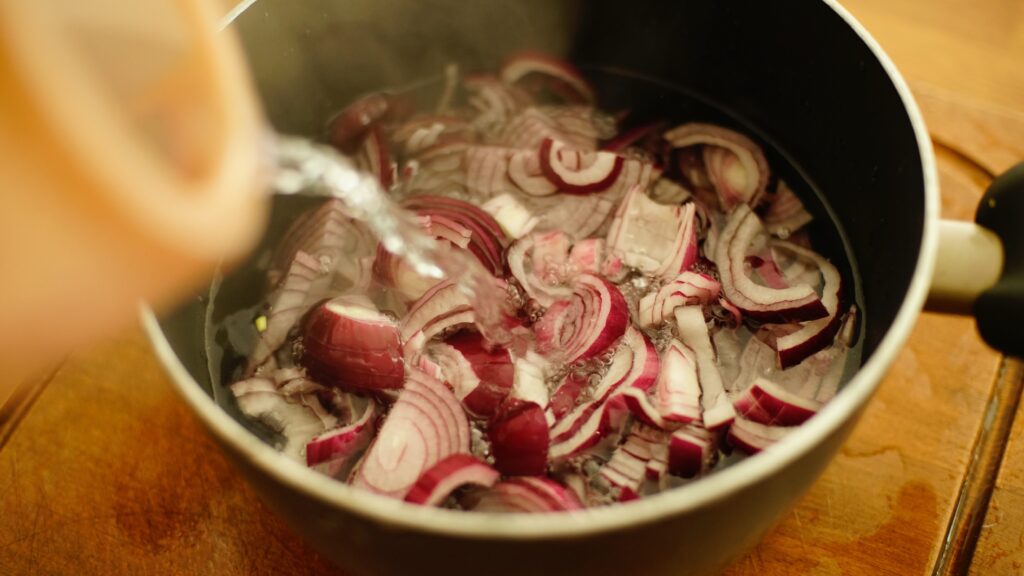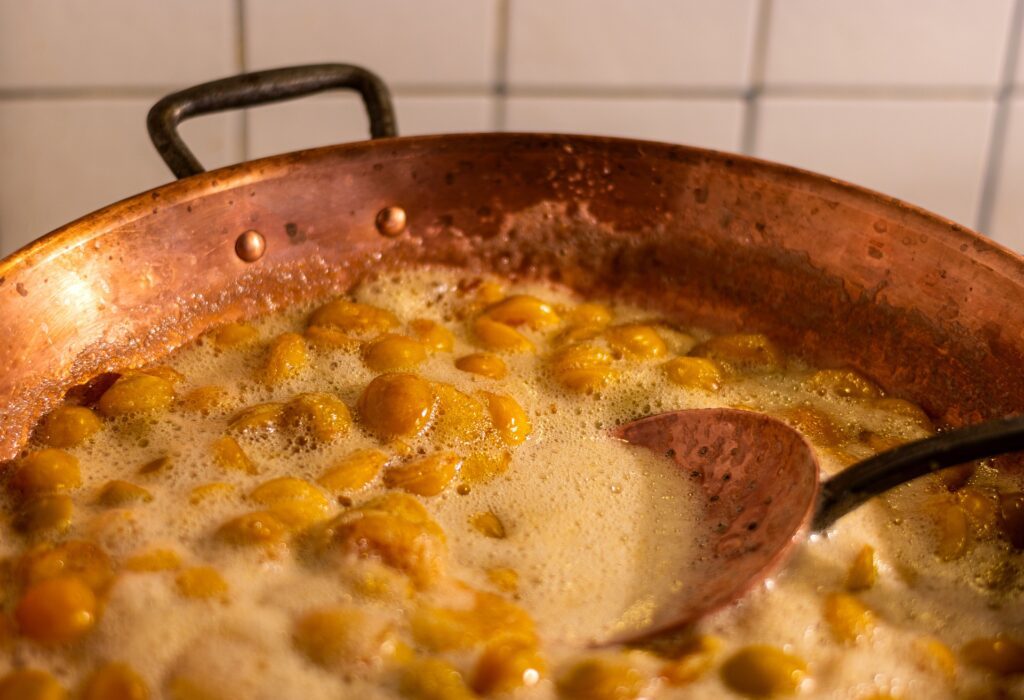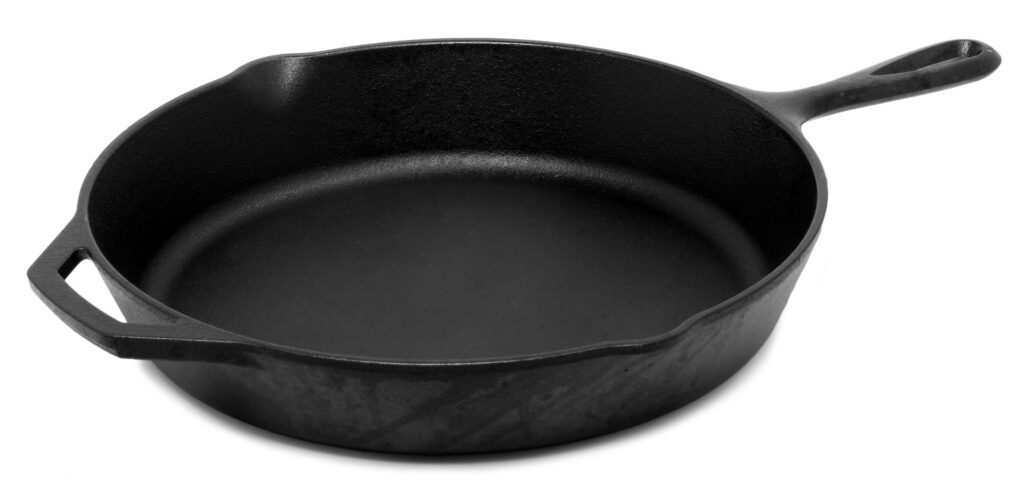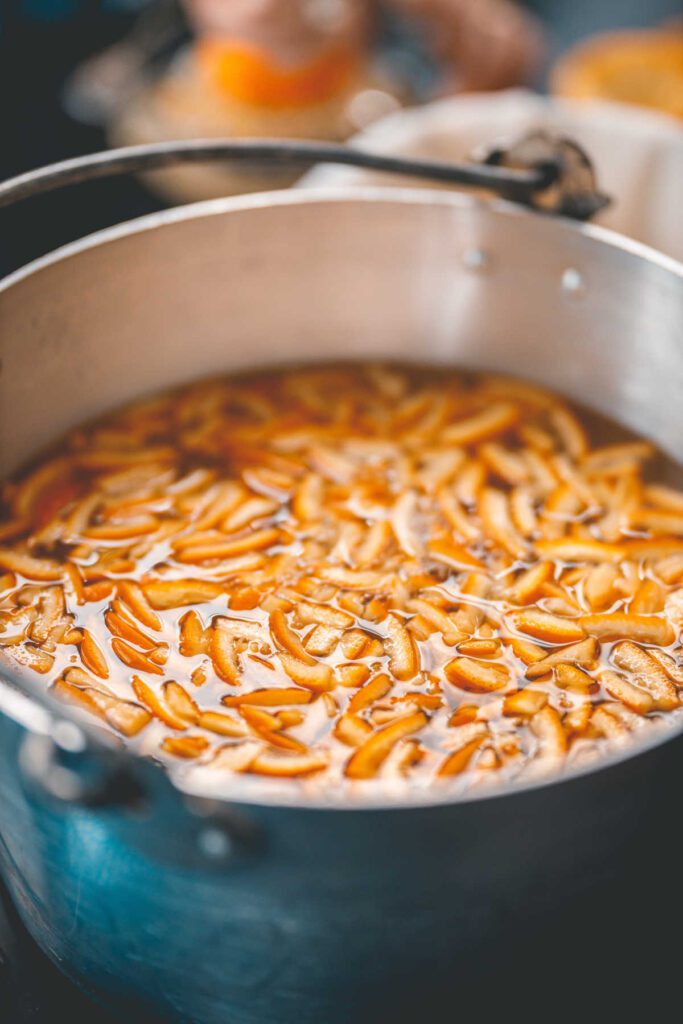While it is possible to make jam without a preserving pan, as a heavy-based saucepan can be used, as with most things, the process is much easier with the right tools. And in terms of tools, a preserving pan is one of the most important and useful tools in your preserving toolkit. It forms the basis of creating all sorts of delicious products, so if you don’t have one yet, take some time to read further about it and the factors to consider ahead of buying one.
What is a preserving pan?
A preserving pan is a large, deep pan that is specially designed for making homemade preserves. They are also known as jam pans or preserving kettles.
It is commonly made from heavy-duty stainless steel, copper or enamel-coated cast iron. This ensures even heat distribution and prevents sticking.

Advantages of a Preserving Pan:
- Unlike a regular saucepan, it has a wide base and flared sides. This design makes it easier to stir the contents and limits the risk of boilovers.
- It also allows for maximum evaporation of the water content in the fruit or vegetables, resulting in a thicker, more concentrated final product.
- Some pans usually have a pouring lip, to make it easy to transfer the hot jam into jars. But this is not included in most available designs anymore. Most likely for safety reasons, as surely lifting a pot of boiling preserves and then pouring cannot to be advised!
Limitations of a Preserving Pan:
- They can be expensive.
- Often a pan can be heavy and bulky due to both design and the materials they are made from. This can present challenges for both storage and transport.
- You have to season certain types of pans before use (cast iron), which can be a time-consuming process.
- Also, the acidic nature of preserves can cause the pan to discolour over time.
It is therefore not unreasonable to think that if you only make jam occasionally that it might not be worth investing in one.
Common types of preserving pans, by material:
1. Copper preserving pan
Many cooks prize copper pans for their ability to evenly distribute heat. But they do require special care to keep them in good condition.
Advantages:
- An advantage of using a pan made from copper is that it is an excellent conductor of heat.
- This means that it heats quickly and evenly, and also loses heat quickly. So, the fruit can cook evenly without hotspots forming, preventing the formation of burnt patches in your jam.
- The copper also looks really good!
Limitations:
- Do not put the chopped fruits in the pan on their own as it is likely that the fruit acids could react poorly with the copper in an unlined pan. So, you should only put a jam mixture of fruit with sugar in a copper pan, together. Sugar supposedly interrupts the potential acidic reaction, which can pose a safety hazard resulting in copper leaching into the preserve. Consequently, you should also never prepare or macerate your fruit in unlined copper. Therefore, many modern types of copper cookware are lined with stainless steel or tin to try to counteract these effects and to make them more usable, and safer.
- In addition, copper salts (which can incrementally accumulate on a corroding copper surface; the greenish stuff being the most recognizable) are often highly soluble and even poisonous. Therefore, it’s crucial to keep your copper pan clean.
- Make sure to only use a mild detergent on your copper-preserving pan, as stronger soaps or detergents can strip the finish and cause the copper to corrode.
- Be careful not to use metal utensils with your copper pan, as these can scratch the surface and also cause corrosion.

- Always store your preserving pan in a dry place, as any overt moisture can again encourage corrosion. Yes, you see the pattern, corrosion can be an issue!
- You must regularly polish these pans to prevent them from developing a patina. Even when lined with a tougher metal, spillage of acidic ingredients can cause the metal to discolour.
- Furthermore, copper pans are relatively expensive, so they may not be accessible to everyone.
Ultimately, whether or not a copper-preserving pan is right for you will depend on your individual needs and preferences. It is important to do your research on this – be aware that you will find a wide range of opposing and strongly held beliefs about the use of copper for cooking.
2. Stainless steel preserving pan
This is the most common type of preserving pan. It has several advantages over other materials.
Advantages:
- Stainless steel is durable and easy to clean, so it’s ideal for repeated use.
- While it may not be the best conductor of heat, it does serve to evenly distribute the heat during the cooking process.
- Its durable construction with a scratch-proof, non-porous surface.
Limitations:
- It is not the best heat conductor, so it takes more time to reach a specific temperature point.
- If you don’t stir mixes often enough foods can stick to the surface, and burn. So, you will need to make adjustments to temperature control and the use of oil or other liquids as a buffer against sticking.
- Beware of cheap stainless steel cookware! Some types can be made from metals like nickel and chromium. And these can leach into foods.
Ultimately, the ideal type of preserving pan for you will depend on your personal preferences, but this is the type I use for preserving.
3. Aluminium preserving pan
Advantages:
Aluminium is one of the most popular materials for cookware.
- It brings an attractive combination of low cost and high conductivity.
- It is lightweight and easy to manoeuvre.
- They are not prone to erosion.
- Aluminium pans heat up quickly and evenly, making them ideal for cooking at high temperatures.
Limitations:
- Aluminium is a reactive metal, which means that it can leach into food, potentially causing health problems. This metal is vulnerable to reacting with acidic foods, including vinegar, citrus and tomatoes. This reaction can also cause the surface to become pitted and stained.
- The downside of being lightweight is that this also brings along a level of fragility. As a result, it is more likely to dent or warp than pans made from other materials. Harsh cleaning methods can easily destroy any lining of the pan.
- For these reasons, aluminium pans are best suited for tasks like frying and sauteing,where quick heating is valued . And while anodised aluminium reduces reactions with acidic foods, this surface still remains vulnerable to harsher cleaning methods.
4. Non-stick preserving pan
Big advantage:
- Reduced likelihood of preserve sticking – this does NOT prevent burning or scorching!
- Being easier to clean. So, more convenient all around.
Limitations:
- Non-stick surfaces are prone to damage from too high heat. At its worst, fumes can even be emitted when over-heated. These fumes have the potential to be harmful to humans and animals, especially those with underlying respiratory conditions. So do NOT use them with very high temperatures (>/= 350 degrees C)
- These pans are more susceptible to being scratched. This makes them less durable and safe in the long term. So, you should not use metal kitchen tools with them.
- Once scratched or chipped the pan is no longer fit for purpose and must be replaced.
5. Enamel preserving pan
Enamel can be a coating to cast iron pans or porcelain pans and the advantages and limitations of enamel pans extend to include those of the underlying or core material.
Advantages:
- The enamel coating is non-reactive, so it won’t interact with the food being cooked.
- It also doesn’t require seasoning, so it’s ready to use right out of the box.
- In addition, the enamel coating is easy to clean and very durable.
Limitations:
- It doesn’t conduct heat as well as other materials.
- Additionally, the enamel coating can chip or crack if it’s abused, so it’s important to be careful when using one of these pans.
6. Cast iron preserving pan
There are many different types of preserving pans on the market, but one of the most popular choices is cast iron.
Advantages:
- They are durable and long-lasting, so you won’t have to replace them frequently.
- While they may be slow to heat, they do maintain the heat once they get there.
- When it has been well-seasoned, it can become non-stick without the need for such synthetic compounds in other non-stick cookware.
Limitations:
- They can be heavy and difficult to lift. The handles, which tend to be cast iron themselves can get very hot with the risk of causing burns.
- Proper seasoning and regular maintenance of the pan are essential to realising its benefits.

- It can require more effort to clean than other types of pans.
- These pans conduct heat fairly poorly, so things take longer to heat, and can be prone to hot spots.
- These pans can react to acidic ingredients with the release of iron into the meal. This may result in a metallic taste, and also be harmful to people who are not able to tolerate additional iron.
- The pan can rust if they are not properly seasoned or maintained.
7. Ceramic preserving pan
A ceramic preserving pan is another choice for those who are looking for an alternative to the traditional metal preserving pan.
Ceramic pans are either fully ceramic or made from quartz sand and clay amongst other things or they are just a silica ceramic coating over a metal core. The latter is more commonly available.
Advantages:
- Ceramic retains heat better than metal, making it ideal for the slow cooking required in preserving.
- In addition, ceramic is non-reactive, so it won’t affect the flavour of the food being preserved or corroded by acid ingredients.
- It comes in a wide range of patterns and colours.
- The surface tends to be non-stick and can tolerate high temperatures. And also does not release fumes like the synthetically-coated non-stick pans can.
- Generally, it’s easy to clean as the surface is naturally non-stick.
Limitations:
- However, ceramic can be more fragile than other pans, so it’s important to take care when using it.
- If coatings are too thin, they may chip or fade. Once this is damaged, the pan loses the same proportion of its non-stick qualities. So you should not use any metal kitchen utensils with this type of preserving pan. This is the most common cause of such a pan needing to be replaced.
- Because the coating can be fragile, this type of pan must be gently cleaned by hand. It is not a dishwasher – safe and this method of cleaning may well start or worsen the chipping of the non-stick coating.
When choosing whether or not to use one, it is important to consider your specific needs and preferences.

What to Consider when Buying Preserving Pan:
1. Size
Make sure to get a preserving pan that is the right size for your needs. You don’t want to end up with one that is too small and can’t hold enough jam or preserves, or one that is too large and takes up too much space in your kitchen.
2. The material the pan is made from and its purpose.
Preserving pans come in a variety of materials. You should choose one that best meets your needs. For example, if you plan on using your preserving pan for jams and jellies, you will want one made from a non-reactive material like stainless steel or enamelled cast iron.
Versatility – These pans can and may be used for other cooking tasks beyond preserving, such as making soup or stew. So if you plan on using your preserving pan for multiple purposes, be sure to choose one that is up to those tasks.
3. Price
Just like anything else, preserving pans come in a range of prices. It is important to find one that fits into your budget without compromising on quality.
4. Ease of use
Look for a pan that is easy to use and has features that make it easy to work with and suit your needs, style, storage and other aspects.
5. Brand & Purchase Terms
Not all preserving pans are created equal.
When choosing one, be sure to select a brand that you trust and that has a good reputation and reviews.
Make sure to consider the warranty and return policy in case you are not satisfied with the product.
6. The type of hob you have
For example, if you have a gas hob, you’ll need a pan with a thick base to prevent scorching. If you have an induction hob, you may want to consider a pan made with a material that conducts heat well. Or make sure to make allowances for any less-than-optimal match between your choice of pan and the hob you use it on.
Given the many variables—mass, thickness, shape, size, and material—it can be tough to compare preserving pans. It also depends on what you’re cooking, the method you are using and who’s doing the cooking.
With a little research, you can find the perfect preserve pan for your needs – one that will help you make delicious jams, jellies, fruit spreads, and more.
If you’re serious about making preserves, it’s worth considering a dedicated preserving pan. A good pan is a useful tool in your preserving kit.
Consider the points in this post, research further and make the best choice to make preserving as easy and pleasurable as enjoying the preserves.